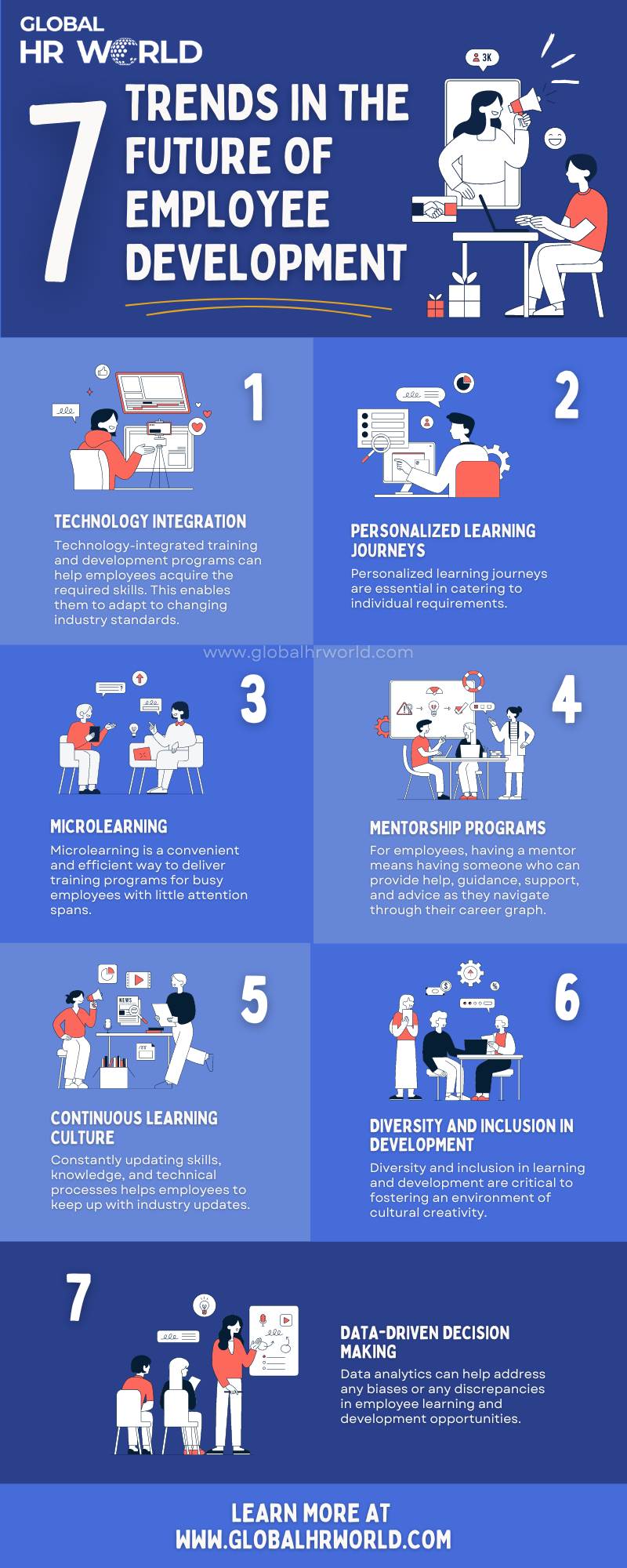There is no doubt that a series of trends are now shaping the current workplace. It has changed the nature of human capital development practice to be more employee-driven. In this blog today, we will look into how you can prepare your organization for the future.
By the way, do you know?

Well, what do you think would be the key reasons? Well, the key reasons for these changes are the latest technologies, changing job roles, and last but not the least, the need for continuous upskilling. Businesses are adapting to the changing workforce and workplace dynamics. They are now prioritizing the future of employee development. Effective employee development activities help to attract and retain top talent. Organizations can adapt their L&D strategy and create dynamic, engaging, and effective learning experiences. This empowers employees and drives business success.
The future of employee development trends
From learning just in the time of need to the integration of AR/VR into learning – L&D professionals need to stay ahead of the curve. They need to design impactful and future-ready learning and development programs. Let’s explore the most critical learning and development trends that all L&D professionals should know.
1 – Technology Integration
As we all know by now, the emergence of Artificial Intelligence (AI) and automation has significantly impacted the skill requirements of an organization. Traditional tasks that humans once had to do are now being automated. This is leading our market to a shift in the demand for skills. For now, organizations need to focus on building a strong skillset through effective technological integration in the future of employee development strategies.
Generative AI empowers L&D teams to deliver efficient, personalized, and engaging learning experiences. It enhances skill development and knowledge transfer within the workforce. Technology-integrated training and development programs can help employees acquire the required skills. This enables them to adapt to changing industry standards. Online learning platforms, virtual and augmented reality simulations, and gamification learning programs are also good options to provide employees with an interactive and engaging learning experience.
2 – Personalized learning journeys
With the focus on shifting standards, providing effective learning opportunities is the number one way to make your employees future-ready. Each employee has different skill sets, strengths, weaknesses, and learning preferences, so personalized learning journeys are essential in catering to individual requirements. A learner-centric approach enables employees to upskill at their own pace using learning techniques that work best for them.
Using learning management systems (LMSs), collaborative e-learning platforms, virtual reality simulations, gamification, and adaptive learning software helps deliver customized learning experiences. Among the primary skills employees need are problem-solving, critical thinking, collaboration, teamwork, relationship-building, and agile thinking. Technical skills like data analysis, programming, and digital literacy are also becoming increasingly important. Therefore, it is important as an organization to organize a clear path for your employees to acquire these skills and help achieve the overall organizational objective.
3 – Microlearning
In today’s fast-paced work environment, employees have limited very time to attend learning programs. That’s why organizations need to come up with quick, just-in-time solutions. Hence, microlearning! Microlearning involves delivering L&D training content in bite-sized formats that learners can easily consume anytime anywhere. It is a convenient and efficient way to deliver training programs for busy employees with little attention spans. The method also allows personalizing learning experiences catering to individual learning preferences. Microlearning methods include explainer videos, podcasts, short blogs, and infographics. These formats support easy retention of knowledge and can be tailored for different learners.
4 – Mentorship programs
Mentorship helps with skill development and career progression for both mentors and employees. For employees, having a mentor means having someone who can provide help, guidance, support, and advice as they navigate through their career graph. It helps them build new skills, gain valuable perspective, and build a broader insight. Mentors can also enhance the leadership skills of the employees.
Effective mentorship programs should have,
- Clear goals and expectations
- The ability to provide a roadmap for the employee’s growth
- Make sure they understand their roles
- A well-thought structure to help both mentors and mentees stay on track.
What else? Virtual mentorship sessions can support the continuous learning needs of employees.
5 – Continuous learning culture
Employee development is no longer a one-time event. Organizations are now actively adapting to the changing nature of employee development. Employees are always looking for opportunities to enhance their skills, knowledge, and technical abilities, leading to professional growth and career advancement.
Therefore, constantly updating skills, knowledge, and technical processes helps employees to keep up with industry updates. Employers must encourage self-directed learning. It encourages employees to take ownership of their own development. Employees can choose their learning road and pursue subjects most relevant to their roles and interests. Employers must openly share their prior experiences with employees and inspire them to engage in learning actively. It promotes a continuous learning mindset throughout the organization. Also, don’t forget to recognize and reward the learning and development efforts of employees. It can be done through certificates, appraisal, or even through small shout-outs during team meetings.
6 – Diversity and inclusion in development
Diversity and inclusion in learning and development are critical to fostering an environment of cultural creativity. Having a diverse group of employee means having individuals from different backgrounds, age groups, cultures, experiences, and ways of pursuing things. A diverse group of employees also helps to build resilience within an organization. Their adaptability to changes is particularly valuable in times of need or crisis.
What else? Employees should have equal opportunities, regardless of race, background, gender, age, or any other demographic factor. Organizations must create a psychologically safe workplace for employees to openly share their ideas and opinions. They should develop DEI-based development strategies that resonate with each individual. It helps to understand the diverse backgrounds and experiences of employees.
7 – Data-driven decision making
Data-driven decision making involves using data analytics to guide decision-making in the future of employee development initiatives. Data analytics can help address any biases or any discrepancies in employee learning and development opportunities. Employers can leverage data from performance assessments, the training records, and survey/feedback forms to assess the effectiveness of their employee development programs. They can select specific skills and behaviors of employees that can lead them to success or if they are still needed. These can be incorporated into the future of employee development programs for others to emulate.
Conclusion
As you can already guess, many of the L&D trends have common themes: the need for contextual learning in the workplace and building new skills for a digital workforce. Therefore, leverage digital applications and technologies to improve the L&D function and use data to influence the future of employee development.
Infographic

Knowledge Check!
Frequently Asked Questions (FAQs)
What do you mean by employee development?
Employee development is the process of helping employees upskill in their careers by acquiring new knowledge and skills.
What are the 4 stages of employee development?
The four phases of employee development are onboarding, initial training, on-the-job training, and retention.
How can organizations help in employee development?
Organizations can adapt their L&D strategy and create dynamic, engaging, and effective learning experiences. This empowers employees and drives business success.



